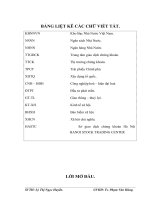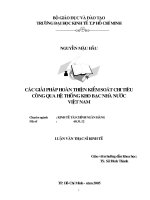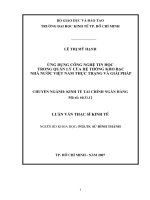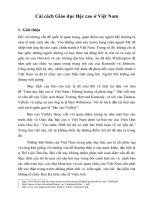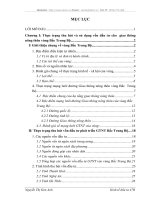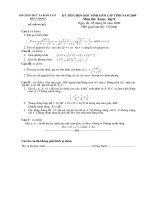Perceived competitiveness of bac giang provincevin viet nam a basic for marketing plan
Bạn đang xem bản rút gọn của tài liệu. Xem và tải ngay bản đầy đủ của tài liệu tại đây (721.11 KB, 154 trang )
PERCEIVED COMPETITIVENESS OF BAC GIANG PROVINCE IN
VIETNAM: A BASIS FOR MARKETING PLAN
___________________________
A DISSERTATION
Presented to the Faculty of the Graduate School
Southern Luzon State University, Lucban, Quezon, Philippines
in Collaboration with
Thai Nguyen University, Socialist Republic of Vietnam
___________________________
In Partial Fulfillment
of the Requirements for the Degree
Doctor of Business Administration
___________________________
By
MAI SON (JACKSON)
December 2013
i
APPROVAL SHEET
The Dissertation of
MAI SON
entitled
PERCEIVED COMPETITIVENESS OF BAC GIANG PROVINCE IN
VIETNAM: A BASIS FOR MARKETING PLAN
Submitted in Partial Fulfilment of the Requirements for the Degree
DOCTOR OF BUSINESS ADMINISTRATION
A program offered by Southern Luzon State University,
Republic of the Philippines in collaboration with
Thai Nguyen University, Socialist Republic of Vietnam
has been approved by Oral Examination Committee
WALBERTO A. MACARAAN, EdD
Expert
EDUARDO T. BAGTANG, DBM
Expert
MELCHOR MELO O. PLACINO, PhD
Expert
ALICE T. VALERIO, PhD
External Panel
CECILIA N. GASCON, PhD
Chairman
Endorsed by:
Recommended by:
EDWIN P. BERNAL, DBA
Adviser
APOLONIA A. ESPINOSA, PhD
Dean
Accepted in Partial Fulfilment of the Requirements for the Degree
Doctor of Business Administration
_____________________
Date
WALBERTO A. MACARAAN, EdD
Vice President for Academic Affairs
ii
CERTIFICATE OF ORIGINALITY
iii
ACKNOWLEDGMENT
I would like to express my deep gratitude to the persons who assisted
and encouraged me to complete the doctoral course. Their help was valuable
for me.
First of all, I would like to thank my parents who gave birth to me. They
have encouraged me to complete this doctoral course not only by words but
by their hearts as supportive parents who are proud of their son.
A thousand thanks to my wife, Trieu Thi Nhung, for her great sacrifice
for me and for my children. She has given me immeasurable help, not only by
raising and teaching our children so that I could have time for my work and
study, but also by pampering me with her good meals, medical care, and
undying love and inspiration. She is a true Vietnamese wife!
Special thanks to my adviser, Professor Edwin Bernal, for his
understanding, encouragement, and support during my candidature. The
completion of this scholarly work would not have been possible without his
guidance and support.
I wholeheartedly thank the entrepreneurs and all the leaders of my
province for their encouragement and for patiently taking time to put their
minds into the work that I completed. Their participation in this project was, to
me, a source of inspiration and motivation so that I continue to dream and to
accomplish noble tasks for my province and for my constituents in our hope of
making a difference in the way we work towards achieving authentic
development for everyone.
iv
The knowledge and skills that I learned and the valuable change in my
attitude and the way I look at the province, my country and the world are
precious jewels that I will bring along with me in my un-ending journey
towards excellence. These definitely are much more than a dissertation.
Mai Son
v
DEDICATION
With much thanks and gratitude,
I wholeheartedly dedicate this dissertation paper
to my parents
Le Thi Cuong and Mai Quang Thuong;
my wife
Trieu Thi Nhung;
and my children
Mai Chi Hieu and Mai Minh Dung.
They have given me valuable support
to complete this hard work.
Without their love and support,
this dissertation would not have been possible.
MS
vi
TABLE OF CONTENTS
PAGE
TITLE PAGE ………………………………………………………………..
i
APPROVAL SHEET ……………………………………………………….
ii
CERTIFICATE OF ORIGINALITY ………………………………………..
iii
ACKNOWLEDGEMENT …………………………………………………..
iv
DEDICATION ………………………………………………………………
vi
TABLE OF CONTENTS …………………………………………………..
vii
LIST OF TABLES ………………………………………………………….
ix
LIST OF FIGURES ………………………………………………………...
xi
ABBREVIATIONS ………………………………………………………….
xii
LIST OF APPENDICES …………………………………………………...
xiii
ABSTRACT …………………………………………………………………
xiv
CHAPTER
I
II
III
INTRODUCTION ……………………………………………
1
Background of the Study …………………………………..
2
Objectives of the Study …………………………………….
3
Hypotheses of the Study ……………………………..……
5
Significance of the Study …………………………………..
5
Scope and Limitation of the Study ………………..………
6
Definition of Terms ………………………………………….
7
REVIEW OF LITERATURE ……………………………….
10
Theoretical Framework ………………………………….…
57
Conceptual Framework ………………………………….…
59
METHODOLOGY …………………………………………..
61
Locale of the Study …………………………………………
61
Research Design ……………………………………………
61
Population, Sample and Sampling Technique …..………
62
Research Instrument ……………………………………….
63
Data Gathering Procedure …………………………………
64
vii
Statistical Treatment ………………………........…….……
67
IV
RESULTS AND DISCUSSIONS ………………………….
68
V
SUMMARY OF FINDINGS, CONCLUSIONS AND
RECOMMENDATIONS
Summary of Findings ………………………………………
98
Conclusions …………………………………………………
100
Recommendations …………………………………………
102
REFERENCES ………………………...…………………………………..
107
APPENDICES ……………………………………………………………...
111
CURRICULUM VITAE …………………………………………………….
138
viii
LIST OF TABLES
TABLE
PAGE
1
Sample Distribution
62
2
Likert Interpretation
63
3
Composition of Respondents According to Working Years
and Type of Business
69
Composition of Respondents According to Line of
Business and Type of Business
70
Composition of Respondents According to Capital Size
and Type of Business
71
Composition of Respondents According to Capital Size
and Number of Employees
72
Over-all Respondents’ Perception on the Competitiveness
of Bac Giang Province by Line of Business
73
Mean Distribution of Respondents’ Perception on the
Competitiveness of Bac Giang Province in Terms of Entry
Costs by Line of Business
74
Mean Distribution of Respondents’ Perception on the
Competitiveness of Bac Giang Province in Terms of Land
Access and Tenure by Line of Business
76
Mean Distribution of Respondents’ Perception on the
Competitiveness of Bac Giang Province in Terms of
Transparency by Line of Business
77
Mean Distribution of Respondents’ Perception on the
Competitiveness of Bac Giang Province in Terms of
Informal Charges by Line of Business
78
Mean Distribution of Respondents’ Perception on the
Competitiveness of Bac Giang Province in Terms of Time
Cost by Line of Business
79
Mean Distribution of Respondents’ Perception on the
Competitiveness of Bac Giang Province in Terms of Proactivity by Line of Business
80
4
5
6
7
8
9
10
11
12
13
ix
TABLE
14
PAGE
Mean Distribution of Respondents’ Perception on the
Competitiveness of Bac Giang Province in Terms of
Business Support Services by Line of Business
81
Mean Distribution of Respondents’ Perception on the
Competitiveness of Bac Giang Province in Terms of Labor
Training by Line of Business
83
Mean Distribution of Respondents’ Perception on the
Competitiveness of Bac Giang Province in Terms of Legal
Institutions by Line of Business
84
17
Descriptive Statistics of Regression
85
18
Model Summary
86
19
ANOVA of Regression
86
20
Results of Estimation
87
21
Comparisons of Respondents’ Perception According to
Profile
89
ANOVA between Working Years and Competitiveness
Factors
90
ANOVA between Type of Business and Competitiveness
Factors
92
ANOVA between Line of Business and Competitiveness
Factors
93
ANOVA between Capital Size and Competitiveness
Factors
95
ANOVA between Number of Employees and
Competitiveness Factors
96
15
16
22
23
24
25
26
x
LIST OF FIGURES
FIGURE
PAGE
1
Theoretical Framework
58
2
Conceptual Framework
60
xi
ABBREVIATIONS
ADB: Asian Development Bank
ASEAN: Association of Southeast Asian Nations
EU: European Union
GDP: Gross Domestic Product
GSO: General Statistic Office
HCM City: Ho Chi Minh City
JICA: Japan International Cooperation Agency
KOICA: Korean International Cooperation Agency
MOLISA: Ministry of Labor, Invalids and Social Affairs
ODA: Official Development Assistance
OLS: Ordinary Least Squares
PCI: Provincial Competitive Index
SMEs: Small Medium Enterprises
SMP: Strategic Market Plan
UNDP: United Nations Development Program
UNESCO: United Nations Educational, Scientific, Cultural Organization
USAID: United States Agency for International Development
VCCI: Vietnam Chamber of Commerce and Industry
VNCI: Vietnam Competitive Index
VND: Vietnamese Dong (Currency of Vietnam)
WB: World Bank
xii
LIST OF APPENDICES
APPENDIX
PAGE
A
Survey Questionnaire
112
B
Statistical Tests of Factors Affecting Respondents’
Perception on the Competitiveness of Bac Giang
Province
115
C
Hypothesis Testing
122
D
Statistical Tests on Respondents’ Perception According to
Related Profile
127
`
xiii
ABSTRACT
Title of Research
: PERCEIVED COMPETITIVENESS OF BAC
GIANG PROVINCE IN VIETNAM: A BASIS
FOR MARKETING PLAN
Researcher
: MAI SON (JACKSON)
Degree Conferred
: DOCTOR OF BUSINESS ADMINISTRATION
Name and Address
of Institution
: Southern Luzon State University, Lucban, Quezon,
Philippines and Thai Nguyen University, Socialist
Republic of Vietnam
Adviser
: Dr. Edwin P. Bernal
Year Written
: 2013
______________________________________________________________
The study aimed to propose a system of criteria to describe the
perceptions of the investors on the factors affecting the provincial
competitiveness of Bac Giang as basis for introducing place marketing
innovations as inputs to the province’s Market Plan model. This study can be
considered as an essential tool for the growth of urban economies in the
global context. The model of place planning based on principles of marketing
named Strategic Market Planning (SMP) that consists of the process of
developing strategies so that a place can reach its growth objectives through
identifying and meeting its target market demand. Place marketing is said to
be both a consequence of, as well as a necessity for, increased competition
among places for the development of resources.
This study basically used the descriptive method of research. It is the
appropriate method for collecting, processing, and analyzing data on the
factors affecting the competitiveness of Bac Giang province, namely entry
costs, land access and tenure, transparency, informal charges, time cost,
xiv
proactive, business support services, labor training and legal institutions. A
correlation method which involved using regression statistics was also used in
this study to analyze the factors that influence the competitive capacity of Bac
Giang province. The study was conducted involving a sample size of 122. The
122 investor-respondents were picked out using random sampling technique.
It was found out that most of the enterprises in Bac Giang are young
and small-medium sized, and the entrepreneurs do not have disparities in
perception to Bac Giang Province's competitiveness. Base on the findings, the
dissertation then suggested nine programs to enhance the competitiveness of
the province including (1) Private-Public Partnership Program, (2) Accelerated
Business Processing and Registration Program, (3) Strategic Belief
Improvement Program, (4) Effective Administration Improvement Program, (5)
Administrative Image Improvement Program, (6) Land Reform Policy
Program, (7) Business Support Service Program, (8) Human Resource
Development Program for Investors and (9) Entrepreneurs and Administrative
Transparency Improvement Program.
Keywords: Strategic Market Planning, Place Marketing, Competitiveness,
Provincial Competitiveness
xv
1
Chapter I
INTRODUCTION
The often-recited mantra of marketing professionals who want to have
the best access to their customers is “Location. Location. Location.”
However, marketing professionals recognize the fact that finding a good
location is one thing but maximizing the potential of a location is another.
Conversely, anyone who is engaged in the marketing of a place needs to fully
understand that location is an area concept and that the potential locators
and/or investors look into some relevant factors that will all redound to the
best possible return on investment. This business concept has a far reaching
implication and covers even the business of a state or its governmental unit
like that of Bac Giang province. As the province technically competes with the
other provinces in attracting investors, both within and outside, there is,
therefore, a need for the province to look seriously into how it can make a
dent in the competition by way of capitalizing on its most relevant competitive
features such as entry costs, land access and tenure, transparency, informal
charges, time cost, proactive, business support services, labor training
and legal institutions.
The desirability of Bac Giang province as a priority investment area
would strongly depend on how existing and potential investors see the
appropriateness of the relevant competitive features of the place. As products
and services are conceptualized on the basis of the customers’ quality,
delivery and price expectations, in like manner, the province shall market the
place primarily on the basis of the investors’ expectations. Therefore, in order
2
to respond to the investors’ expectations, it is imperative that place marketing
innovations should find their way into the province’s strategic development
plan to attain a holistic approach in enhancing the province’s competitiveness
for attracting investors.
Background of the Study
In the past years, strategic market planning had been used as a
strategy for enhancing competitiveness that led to achieving growth in the
economies of some successful cities worldwide. Some scholars have judged
this approach as an essential tool for the growth of urban economies in the
global context (Ashworth 1994; Ashworth & Voogd 1990; Gold 1994; Jessop
1998; Kotler et al. 1999; Kotler, Haider & Rein 1993; Kotler et al. 2002; Levine
1998; Luo & Zhao 2003; Wells & Alvin 2000). They have been generalizing
and conceptualizing this phenomenon in an effort to build a model of place
planning based on the principles of marketing. Kotler (ibid.) named this
approach as Strategic Market Planning (SMP) which consists of the process
of developing strategies so that a place can reach its growth objectives
through identifying and meeting its target market demand. A place’s target
market might be businesses and entrepreneurs, visitors, residents, investors,
donors and international financing institutions.
Place marketing is said to be both a consequence of, as well as a
necessity for, increased competition among places for the development of
resources. The concept of city marketing has gained increasing attention as a
means of enhancing the competitiveness of cities (Paddison 1993 cited in
3
Short & Kim 1998). In the effort to respond to the demands of competition
and to attract the desired target groups, place administrators have recognized
in marketing theory and practice a valuable ally (Kavaratzis, 2005). Some
scholars pointed out that competition among places is not new. Cities have
always existed within a market context of one sort or another, and they
compete among one another for resources, activities, residents and services
(Ashworth & Voogd, 1990). Many examples of marketing solutions, mainly
promotional measures, which cities used in much earlier time, were provided
in Ward (1998). However, these early place marketing activities were intuitive
and random (Kavaratzis, 2005; Ward, 1998), whereas a more focused,
integrated and strategic implementation of place marketing has been evident
in recent decades (Kotler et al. 2002). The reason given for this change is
increased competition among places as a response to fundamental changes
in markets, investment and technology as a result of a common globalization
trend in which people, capital, and companies have become more footloose
(Kotler et al., 2002; Short & Kim, 1998).
The competition among developing places and/or among postindustrial cities has resulted in more aggressive and complex forms of
competition. As a consequence of the increasingly wide-ranging and
aggressive competition, a place marketing strategy for retaining and attracting
investment has become essential.
Objectives of the Study
The general objective of this study was to describe the perceptions of
the investors on the factors affecting the competitiveness of Bac Giang
4
province as a basis for introducing place marketing innovations into the
Strategic Market Planning (SMP) model for the province.
Specifically, this study aimed:
1. To describe the profile of the respondents in terms of:
a) Working years
b) Type of business
c) Line of business
d) Capital size
e) Numbers of employees
2. To analyze the competitiveness of Bac Giang Province based on
the perception of the investors measured in terms of:
a) Entry costs
b) Land access and tenure
c) Transparency
d) Informal charges
e) Time cost
f) Pro-activeness
g) Business support services
h) Labor training
i) Legal institutions.
3. To determine factors affecting the competitive capacity of Bac
Giang Province.
4. To compare perceived competitiveness when the investors
respondents are grouped in terms of selected characteristics.
5
Hypotheses of the Study
Hypothesis 1: There are significant relationships between the
competitiveness factors (independent variables), namely entry costs, land
access and tenure, transparency, informal charges, time cost, pro-activeness,
business support services, labor training and legal institutions, and the
competitive capacity of Bac Giang Province.
Hypothesis 2: There is no significant difference between the
respondents’ perception when they were grouped by selected profile.
Significance of the Study
The result of this study is envisioned to contribute knowledge to
effective and efficient management; hence, it will benefit the following:
For the investors, this paper will enable the Bac Giang’s government
to build special action plans to improve the competitiveness of the province.
Hence, the investors may have more facilities, infrastructure, and relevant
services by the time they invest in Bac Giang.
For Bac Giang government, this study will help government
administrators to understand the province’s strengths and weaknesses. In
addition, Bac Giang’s government will understand what investors are thinking
about business environment of the province, especially in terms of entry
costs, land access and tenure, transparent, informal charges, time cost, proactiveness, business support services, labor training and legal institutions.
6
Hence, the government can build action plans to improve business
environment of Bac Giang province in order to attract more investors.
For the researcher, this is the first research which proposes a
combination of theories of place planning, marketing and regimes to provide a
new theoretical base for the practice of place planning. This theoretical base,
as judged by the practice outcomes with the case study in Bac Giang
Province, will bring a deep understanding on the applicability of this theory to
practice. The judgment will assist to develop a theoretical perspective toward
a more appropriate SMP model for the provinces in Vietnam. This study will
help the researcher acquire skills in research method, to obtain useful
knowledge of management at provincial level. This research is the foundation
for the researcher to propose possible solutions for trouble in the Bac Giang
province's competitive capacity.
Scope and Limitation of the Study
Based on the perception of investor-respondents, the study assessed
the competitive capacity of Bac Giang province in terms of the following major
nine variables: entry costs, land access and tenure, transparent, informal
charges, time cost, pro-activeness, business support services, labor training
and legal institutions. The study was confined in Bac Giang Province only and
involved respondents coming from 122 local enterprises.
On the basis of these analyses, the paper came up with some
meaningful recommendations on how the province will proceed at formulating
7
strategies in order to effectively market the place and hopefully attract
investors to put their resources in the province.
Definition of Terms
The following terms were defined conceptually and operationally for
better understanding:
Business Support Service is a measure of provincial policies for private
sector trade promotion, business partner matchmaking, etc. It attempts
to measure how well provincial officials are performing in resolving
these problems on behalf of the firms.
Entry costs, a measure of the time and difficulty it takes firms to register,
acquire land, and receive all the necessary licenses to start business.
Informal Charges the indicator whether the presence or the absence of
informal charges makes the province more competitive.
Labor Training is a measure of the efforts by provincial authorities to
promote vocational training and skills development for local industries
and to assist in the placement of local labor.
Land access and tenure, a measure of how easy it is for firms to access
land. In 2006, this sub-index has been amended to include one new
dimension to measure the security of tenure once land is acquired. The
first dimension comprises whether firms possess their official land use
rights certificates, whether they have enough land for their business
expansion requirements, whether they are renting from SOEs and an
assessment of land conversion efforts. The second dimension includes
8
perceptions of various tenure security risks such as expropriation,
unfair compensation values or changes in the lease contract) as well
as the duration of tenure.
Legal Institutions is a measure of the confidence of the private sector in the
provincial legal institutions, whether firms regard provincial legal
institutions as an effective vehicle for dispute resolution or as an
avenue for lodging appeals against corrupt official behavior.
Line of business (LOB) is a set of one or more highly related products or
services where a business generates revenue.
Pro-activeness of Provincial Leadership is a measure of the creativity and
cleverness of provinces in both implementing central policy, designing
their own initiatives for private sector development, and working within
sometimes unclear national regulatory frameworks to assist and
interpret in favor of local private firms.
Provincial Competitiveness Index (PCI) refers to the set of indices
formulated by Vietnam Chamber of Commerce and Industry (VCCI)
which was a USAID-funded Vietnam Competitiveness Initiative (VNCI)
on assisting the competition to go in the right direction, relying on
private business’ perceptions of the local business environment, as
well as credible and comparable data from official and other sources
regarding local conditions.
Strategic Market Planning is a process that allows an organization to
concentrate its resources on the optimal opportunities with the goals of
increasing sales and achieving a sustainable competitive advantage.
Strategic market planning includes all basic and long-term activities in
9
the field of marketing that deal with the analysis of the strategic initial
situation of a company and the formulation, evaluation and selection of
market-oriented strategies and therefore, contributes to the goals of the
company and its marketing objectives. As used in this study, strategic
market planning refers, specifically, to the process involved on how the
Bac Giang province should create place marketing innovations towards
a long-term strategy of making the province a competitive destination
and beneficiary of productive investments.
Transparency and Access to Information, a measure of whether firms have
access to the proper planning and legal documents necessary to run
their business, whether those documents are equitably available,
whether new policies and laws are communicated to firms and
predictably implemented, and the business utility of the provincial web
page.
Time Costs of Regulatory Compliance, a measure of how much time firms
waste on bureaucratic compliance as well as how often and how long
firms must shut down their operations for inspections by local
regulatory agencies. As such, it considers two dimensions of time
costs, which are weighted equally, Bureaucratic Procedures and Time
Lost to Inspections.
Type of business refers to the legal forms of business entity such as
corporations, cooperatives, partnerships, sole proprietorships.
Working years refers to the length of time (in years) that an investor
respondent had been working for and with the company.
10
CHAPTER II
REVIEW OF LITERATURE
This chapter discusses the literatures and the studies having significant
bearing on this study which was aimed at providing relevant inputs to the Bac
Giang province’s formulation of strategic market plan to market its place,
particularly, among investors. The theoretical framework and the conceptual
framework which served as an important guide for undertaking and
completing this research project are, as well, presented in this chapter.
As this research project carries an inherent responsibility to be able to
contribute to the development of theory in the field of business administration,
it is but necessary that the researcher must possess a thorough familiarity
with both the related theory and previous research outputs. This is the reason
why this review was conducted.
Specifically, this review allowed the
assessment of the amount of work done in the area on place marketing as
well as in the general context of strategic market planning as a tool for
enhancing competitiveness. Needless to say, the review has provided some
strong bases for formulating relevant insights regarding strong points and
limitation of the previous studies while enabling the creation of unbiased
perspective which led to the improvement of the current investigation.
Brief Background of Bac Giang Province
Bac Giang province is a competitor in attracting investment. Located at
the Nanning (China) - Lang Son - Hanoi - Hai Phong economic corridor and
adjacent to the northern key economic region covering Hanoi, Hai Phong and
